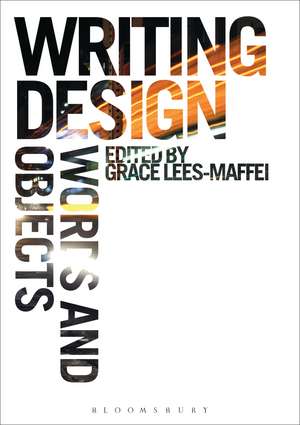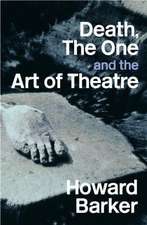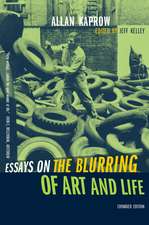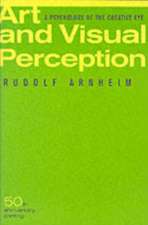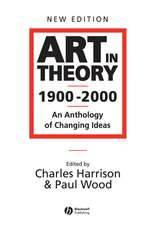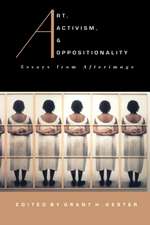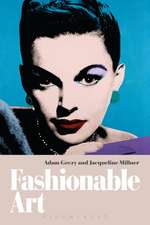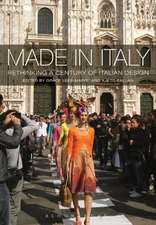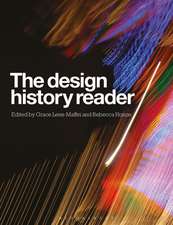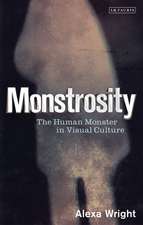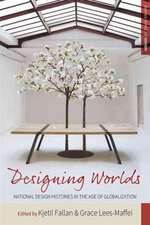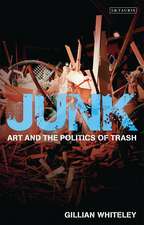Writing Design: Words and Objects
Editat de Grace Lees-Maffeien Limba Engleză Paperback – 30 noi 2011
Preț: 241.89 lei
Preț vechi: 275.79 lei
-12% Nou
Puncte Express: 363
Preț estimativ în valută:
46.29€ • 48.15$ • 38.22£
46.29€ • 48.15$ • 38.22£
Carte tipărită la comandă
Livrare economică 14-28 aprilie
Preluare comenzi: 021 569.72.76
Specificații
ISBN-13: 9781847889553
ISBN-10: 1847889557
Pagini: 288
Ilustrații: 51 bw illus
Dimensiuni: 172 x 244 x 15 mm
Greutate: 0.57 kg
Editura: Bloomsbury Publishing
Colecția Berg Publishers
Locul publicării:London, United Kingdom
ISBN-10: 1847889557
Pagini: 288
Ilustrații: 51 bw illus
Dimensiuni: 172 x 244 x 15 mm
Greutate: 0.57 kg
Editura: Bloomsbury Publishing
Colecția Berg Publishers
Locul publicării:London, United Kingdom
Caracteristici
Addresses issues such as the role of text in informing design consumption, designing with and through language, and the challenges and opportunities of designing without language
Notă biografică
Grace Lees-Maffei is Reader in Design History in the School of Creative Arts at the University of Hertfordshire and is co-editor of The Design History Reader (Berg, 2010).
Cuprins
Acknowledgements
General Introduction, Grace Lees-Maffei
PART 1: RIGHTING DESIGN - ON THE REFORMING ROLE OF DESIGN CRITICISM
Introduction
1. 'Writing about Stuff': The Peril and Promise of Design History and Criticism, Jeffrey L. Meikle, University of Texas at Austin, USA
2. Design Criticism and Social Responsibility: The Flemish Design Critic K.-N. Elno (1920-1993), Fredie Floré, Ghent University, Belgium
3. The Metamorphosis of a Norwegian Design Magazine: Nye Bonytt, 1968-1971, Kjetil Fallan, University of Oslo, Norway
4. Writing Contemporary Design into History, Stephen Hayward, University of the Arts London, UK
PART 2: MEDIATIONS - BETWEEN DESIGN AND CONSUMPTION
Introduction
5. Thinking in Metaphor: Figurative Conceptualising in John Evelyn's Diary and John Ruskin's Stones of Venice, Anne Hultzsch, University College London, UK
6. Regulating the Body in Army Manuals and Trade Guides: The Design of the First World War Khaki Service Dress, Jane Tynan, University of the Arts London, UK
7. Vitaglass and the Discourse of Modern Culture, John Stanislav Sadar, Monash University, Australia
8. Lewis Mumford's Lever House: Writing a House of Glass, Ann Sobiech Munson, Iowa State University, USA
PART 3: DESIGNING WITH AND THROUGH LANGUAGE
Introduction
9. Judging a Book by its Cover: or Does Modernist Form Follow Function?, Polly Cantlon and Alice Lo, both University of Waikato, New Zealand
10. Reading Details: Caruso St John and the Poetic Intent of Construction Documents, Mhairi McVicar, Welsh School of Architecture, UK
11. Applying Oral Sources: Design Historian, Practitioner and Participant:, Chae Ho Lee, University of Hawai'i at Mânoa, USA
12. Fluid Typography: Construction, Metamorphosis and Revelation, Barbara Brownie, University of Hertfordshire, UK
PART 4: SHOWING AS TELLING - ON DESIGN BEYOND TEXT
Introduction
13. Showing Architecture Through Exhibitions: A Taxonomical Analysis Applied to the Case of the First Venice Architecture Biennale (1980), Léa-Catherine Szacka, University College London, UK
14. Design as Language without Words: AG Fronzoni, Gabriele Oropallo, University College London, UK
15. On the Legal Protection of Design: Things and Words about Them, Stina Teilmann-Lock, Danish Design School, Denmark
16. Text-led and Object-led Research Paradigms: Doing Without Words, Michael Biggs and Daniela Büchler, both University of Hertfordshire, UK
Contributors
List of Illustrations
Select Bibliography
Index
General Introduction, Grace Lees-Maffei
PART 1: RIGHTING DESIGN - ON THE REFORMING ROLE OF DESIGN CRITICISM
Introduction
1. 'Writing about Stuff': The Peril and Promise of Design History and Criticism, Jeffrey L. Meikle, University of Texas at Austin, USA
2. Design Criticism and Social Responsibility: The Flemish Design Critic K.-N. Elno (1920-1993), Fredie Floré, Ghent University, Belgium
3. The Metamorphosis of a Norwegian Design Magazine: Nye Bonytt, 1968-1971, Kjetil Fallan, University of Oslo, Norway
4. Writing Contemporary Design into History, Stephen Hayward, University of the Arts London, UK
PART 2: MEDIATIONS - BETWEEN DESIGN AND CONSUMPTION
Introduction
5. Thinking in Metaphor: Figurative Conceptualising in John Evelyn's Diary and John Ruskin's Stones of Venice, Anne Hultzsch, University College London, UK
6. Regulating the Body in Army Manuals and Trade Guides: The Design of the First World War Khaki Service Dress, Jane Tynan, University of the Arts London, UK
7. Vitaglass and the Discourse of Modern Culture, John Stanislav Sadar, Monash University, Australia
8. Lewis Mumford's Lever House: Writing a House of Glass, Ann Sobiech Munson, Iowa State University, USA
PART 3: DESIGNING WITH AND THROUGH LANGUAGE
Introduction
9. Judging a Book by its Cover: or Does Modernist Form Follow Function?, Polly Cantlon and Alice Lo, both University of Waikato, New Zealand
10. Reading Details: Caruso St John and the Poetic Intent of Construction Documents, Mhairi McVicar, Welsh School of Architecture, UK
11. Applying Oral Sources: Design Historian, Practitioner and Participant:, Chae Ho Lee, University of Hawai'i at Mânoa, USA
12. Fluid Typography: Construction, Metamorphosis and Revelation, Barbara Brownie, University of Hertfordshire, UK
PART 4: SHOWING AS TELLING - ON DESIGN BEYOND TEXT
Introduction
13. Showing Architecture Through Exhibitions: A Taxonomical Analysis Applied to the Case of the First Venice Architecture Biennale (1980), Léa-Catherine Szacka, University College London, UK
14. Design as Language without Words: AG Fronzoni, Gabriele Oropallo, University College London, UK
15. On the Legal Protection of Design: Things and Words about Them, Stina Teilmann-Lock, Danish Design School, Denmark
16. Text-led and Object-led Research Paradigms: Doing Without Words, Michael Biggs and Daniela Büchler, both University of Hertfordshire, UK
Contributors
List of Illustrations
Select Bibliography
Index
Recenzii
Writing Design is long overdue. For well over a century, critics, historians, theorists and designers themselves have used a multitude of words to describe, suggest, denote, evoke and critique that evasive concept of 'design'. Now, for the first time, a group of scholars have set out to reflect on that long-standing practice and to make us think more deeply about the complex relationship that exists between words and things.
This volume promises to become essential reading for anyone interested in the historical and contemporary circumstances by which words describe design, and design defines language. From a range of international perspectives, the book's contributors show how the interrelationship between language and design is never passive, but always subject to mediation, negotiation, and at times contestation.
Writing Design will be a pivotal book on the fast-filling Design Criticism bookshelf. Design Criticism manifests variously as a journalistic practice, a mode of political resistance, a literary genre, an interpretive tool - and now as an academic discipline. The growing number of pedagogical initiatives in Design Criticism demands a literature that supports and challenges these academic endeavours with new research, provocative thinking and thoughtful analysis. Writing Design collects important scholarship - representing a spectrum of approaches, viewpoints, and geographical origins - that explores the rich relationship between design and language and draws attention to the written word as an artefact, worthy of as much scrutiny as the designed entity it describes. As such, this carefully selected compendium of essays helps to stake out the territory, and provides students with a broad view of the field, its key debates, themes and issues, as well as with inspiration for their own research, and case studies for close analysis. I look forward to the Design Criticism bookshelf soon groaning under the weight of many more anthologies, theoretical treatises, narrative histories and polemical tracts of the same calibre as this pioneering volume.
This volume promises to become essential reading for anyone interested in the historical and contemporary circumstances by which words describe design, and design defines language. From a range of international perspectives, the book's contributors show how the interrelationship between language and design is never passive, but always subject to mediation, negotiation, and at times contestation.
Writing Design will be a pivotal book on the fast-filling Design Criticism bookshelf. Design Criticism manifests variously as a journalistic practice, a mode of political resistance, a literary genre, an interpretive tool - and now as an academic discipline. The growing number of pedagogical initiatives in Design Criticism demands a literature that supports and challenges these academic endeavours with new research, provocative thinking and thoughtful analysis. Writing Design collects important scholarship - representing a spectrum of approaches, viewpoints, and geographical origins - that explores the rich relationship between design and language and draws attention to the written word as an artefact, worthy of as much scrutiny as the designed entity it describes. As such, this carefully selected compendium of essays helps to stake out the territory, and provides students with a broad view of the field, its key debates, themes and issues, as well as with inspiration for their own research, and case studies for close analysis. I look forward to the Design Criticism bookshelf soon groaning under the weight of many more anthologies, theoretical treatises, narrative histories and polemical tracts of the same calibre as this pioneering volume.
Descriere
Explains how important language is to understanding design, how a range of texts - from design criticism to instructions and labels - shape the appreciation and use of design.
